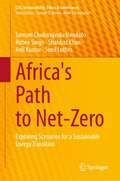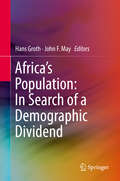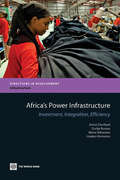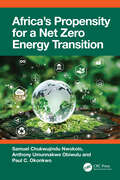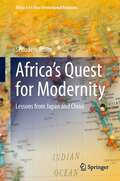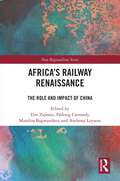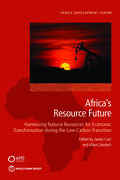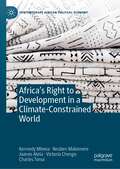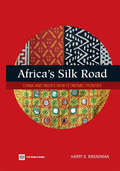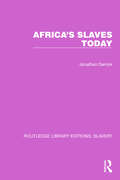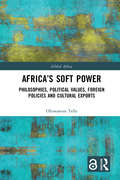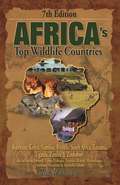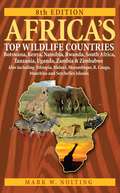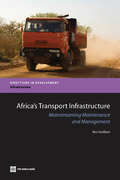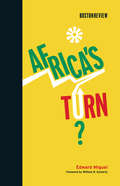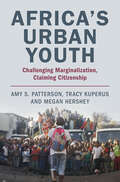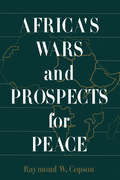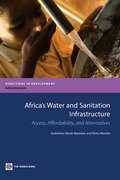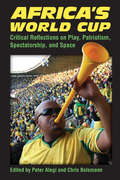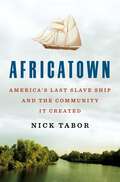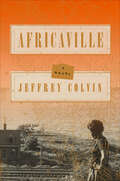- Table View
- List View
Africa's Path to Net-Zero: Exploring Scenarios for a Sustainable Energy Transition (CSR, Sustainability, Ethics & Governance)
by Samuel Nwokolo Rubee Singh Shahbaz Khan Anil Kumar Sunil LuthraThis book provides a comprehensive analysis of the challenges and opportunities for achieving a net-zero energy transition in Africa. With a focus on policy, technology, financing, and socio-political factors, the book presents four potential scenarios for a sustainable energy transition in the continent. The scenarios presented highlight the importance of balancing economic growth with environmental sustainability and social development. While foreign investments in renewable energy could be beneficial, they must be carefully monitored and regulated to prevent exploitation and ensure accountability. The book also emphasizes the need for collaboration and a calculated transition to ensure that all stakeholders are involved in the process. Additionally, the challenges of achieving self-sufficiency and export-free energy are discussed, with the importance of setting limitations and regulations to prevent a vicious cycle of poverty and dependency on foreign aid. With a deep understanding of Africa's environmental, socio-political, and socio-cultural complexities, “Africa's Path to Net-Zero” offers valuable insights for policymakers, investors, and anyone interested in promoting a sustainable energy future for the continent.
Africa's Population: In Search of a Demographic Dividend
by John F. May Hans GrothThis book examines the promises as well as the challenges the demographic dividend brings to sub-Saharan Africa as fertility rates in the region fall and the labor force grows. It offers a detailed analysis of what conditions must be met in order for the region to take full economic advantage of ongoing population dynamics. As the book makes clear, the region will need to accelerate reforms to cope with its demographic transition, in particular the decline of fertility. The continent will need to foster human capital formation through renewed efforts in the areas of education, health and employment. This will entail a true vision and determination on the part of African leaders and their development partners. The book will help readers to gain solid knowledge of the demographic trends and provide insights into socioeconomic policies that eventually might lead sub-Saharan Africa into a successful future.
Africa's Power Infrastructure
by Anton Eberhard Orvika Rosnes Maria Shkaratan Haakon VennemoAfrica's chronic power problems have escalated in recent years into a crisis affecting 30 countries, taking a heavy toll on economic growth and productivity. The region has inadequate generation capacity, limited electrification, low power consumption, unreliable services, and high costs. It also faces a power sector financing gap on the order of $21 billion a year. It spends only about a quarter of what it needs to spend on power, much of this on operating expenditure required to run the continent's high-cost power systems, leaving little for the huge investments needed to provide a long-term solution. Further development of regional power trade would allow Africa to harness larger scale more cost-effective energy sources, reducing energy system costs by $2 billion a year and saving 70 million tons of carbon emissions annually. Economic returns to investments in cross-border transmission are particularly high. But reaping the promise of regional trade depends on a handful of major exporting countries raising the large volumes of finance needed to develop generation capacity for export. It would also require political will in a large number of importing countries that could potentially meet more than half their power demand through trade. Power sector inefficiencies are high, deterring investment in new capacity and electrification. There are three types of sector inefficiencies. First, there are utility inefficiencies, which include system losses, under-collection of revenue and over-manning. These result in a major waste of resources adding up to $4.40 billion a year. Under-collection is the largest component of utility inefficiencies amounting to $1.73 billion, following by system losses at $1.48 billion and by over-manning at $1.15 billion. The second type of sector inefficiency is under-pricing of power. By setting tariffs below the levels needed to cover the actual costs, SSA countries forego revenues of $3.62 billion a year. The third type of inefficiency is poor budget execution. Only 66% of the capital budgets allocated to power are actually spent, with about $258 million in public investment earmarked for the power sector being diverted elsewhere in the budget. Full cost recovery tariffs would already be affordable in countries with efficient large scale hydro or coal-based systems, but not in those relying on small scale oil-based plants. Once regional power trade comes into play, generation costs will fall, and full cost recovery tariffs could be affordable in much of Africa. One of the key policy challenges is to strengthen sector planning capabilities, too often overlooked in today's hybrid markets. A serious recommitment to reforming state-owned enterprises should emphasize improvements in corporate governance more than purely technical fixes. Improving cost recovery is essential for sustaining investments in electrification and regional power generation projects. Closing the huge financing gap will require improving the creditworthiness of utilities and sustaining the recent upswing in external finance to the sector This book is based on extensive data collection undertaken between 2006 and 2008 by the Africa Country Infrastructure Country Diagnostic, an initiative of the Infrastructure Consortium for Africa delegated to the World Bank under the guidance of the African Union, African Development Bank and other multi-lateral and bilateral development institutions.
Africa’s Propensity for a Net Zero Energy Transition
by Samuel Chukwujindu Nwokolo Anthony Umunnakwe Obiwulu Paul C. OkonkwoThis book explores the issue of a sustainable energy transition in Africa, including the current energy landscape and exploration of various scenarios for achieving net zero emissions. It highlights the challenges faced by African countries in transitioning to clean energy and provides practical solutions for these challenges. It provides perceptive analysis and case studies demonstrating how African nations can take advantage of their natural resources, including insights from Bhutan and Denmark to achieve sustainable development while mitigating the effects of climate change.Features: Offers unique insights into the specific challenges and opportunities that Africa faces in achieving a net zero energy future. Provides comprehensive understanding of the region's renewable energy potential, including analysis of policies and initiatives driving sustainable development. Highlights successful case studies, emerging technologies, and the economic and environmental benefits of transitioning to net zero energy. Explores the role of international collaborations and partnerships in supporting Africa's journey toward a net zero energy future. Discusses solutions that must be tailored to the specific needs and contexts of African countries. This book is aimed at graduate students and researchers in the field of sustainability and energy systems.
Africa’s Quest for Modernity: Lessons from Japan and China (Africa-East Asia International Relations)
by Seifudein AdemThis monograph addresses the complexity of China-Africa and Japan-Africa relations from a comparative perspective. The volume is divided into five sections. Section I focuses on the divergent perspectives that are reflected in the discourse on China-Africa relations. Section II discusses Japan’s economic modernization and its potential lessons for Africa. Section III compares the foreign policies of Japan and China in Africa and analyzes their supposed rivalries on the continent. Section IV explores the relationship between Southeast Asia and China and its relevance to Africa-China relations. Section V provides an in-depth case study of Ethiopia-China relations over the last century. The book fills a major gap in the existing literature on the triad of Africa, China, and Japan. Under the guidance of the disciplines of African studies, international relations, political sociology, and international political economy, this volume elucidates and examines the complexities of the foreign policies of the two Asian powers toward Africa as well as their economic, political, and cultural underpinnings.
Africa’s Railway Renaissance: The Role and Impact of China (New Regionalisms Series)
by Tim ZajontzThis book investigates the history, political economy and spatiality of Chinese railway projects in Africa. It examines the financial governance of Sino-African railway projects, their socio-cultural, political and economic effects as well as the regional dimension of Africa’s new railway architecture and its function within China’s Belt and Road Initiative. Leading and emerging scholars from Africa, China, Europe and the Americas offer interpretations through politico-economic, historical, geographical and post-colonial conceptual lenses. Case studies on projects in Angola, Ethiopia, Kenya, Nigeria, Tanzania and Zambia offer an empirically rich and cross-disciplinary picture of Sino-African railway developments at the micro-, meso- and macro-levels. Regional analyses on West and East Africa expose persistent obstacles to the regional integration of Africa’s railways. The volume outlines opportunities and challenges related to Africa’s railway renaissance in the post-Covid-19 global political economy and will be of great interest to academics, students and practitioners interested in Africa-China relations and their developmental effects or in the politics of infrastructure, spatial governance and the political economy of transport.
Africa's Resource Future: Harnessing Natural Resources for Economic Transformation during the Low-Carbon Transition (Africa Development Forum)
by James Cust and Albert ZeufackThis book examines the role for natural resource wealth in driving Africa’s economic transformation and the implications of the low-carbon transition for resource-rich economies. Resource wealth remains central to most Sub-Saharan African economies, and significant untapped potential is in the ground. Subsoil assets—such as metals, minerals, oil, and gas—are key sources of government revenues, export earnings, and development potential in most countries in the Africa region. Despite large reserves, success in converting subsoil wealth into aboveground sustainable prosperity has been limited. Since the decline in commodity prices in 2014, resource-rich Africa has grown more slowly than the region’s average growth rate. Finding ways to more effectively harness natural resource wealth to drive economic transformation will be central to Africa’s economic future. As the world moves away from fossil fuels in alignment with commitments under the Paris Agreement, Africa’s resource-rich countries face new risks and opportunities. Recent estimates suggest that 80 percent of the world’s proven fossil fuel reserves must remain underground to meet the Paris targets, and much of these stranded reserves may be in Africa. This issue of stranded assets and, relatedly, “stranded nations,†? has major implications for the many African economies that are dependent on petroleum extraction and export. On the other hand, the energy transition will increase demand for raw material inputs involved in clean energy technologies. The transition from fossil fuels to clean energy may create demand by 2050 for 3 billion tons of minerals and metals that are needed to deploy solar, wind, and geothermal energy. How can African economies tap into these opportunities while managing the downside risk to their fossil fuel wealth? Africa’s Resource Future explores these themes and offers policy makers insights to help them navigate the coming years of uncertainty.
Africa’s Right to Development in a Climate-Constrained World (Contemporary African Political Economy)
by Kennedy Mbeva Reuben Makomere Joanes Atela Victoria Chengo Charles TonuiThis book examines how Africa can secure a ‘just transition’ to low-carbon, climate-resilient economies.
Africa's Silk Road: China and India's New Economic Frontier
by Harry G. BroadmanChina and India's new-found interest in trade and investment with Africa - home to 300 million of the globe's poorest people and the world's most formidable development challenge - presents a significant opportunity for growth and integration of the Sub-Saharan continent into the global economy. Africa's Silk Road finds that China and India's South-South commerce with Africa is about far more than natural resources, opening the way for Africa to become a processor of commodities and a competitive supplier of goods and services to these countries - a major departure from its long established relations with the North. A growing number of Chinese and Indian businesses active in Africa operate on a global scale, work with world-class technologies, produce products and services according to the most demanding standards, and foster the integration of African businesses into advanced markets.There are significant imbalances, however, in these emerging commercial relationships. These can be addressed through a series of reforms in all countries: 'At-the-border' reforms, such as elimination of China and India's escalating tariffs on Africa's leading exports, and elimination of Africa's tariffs on certain inputs that make exports uncompetitive 'Behind-the-border' reforms in Africa, to unleash competitive market forces and strengthen its basic market institutions 'Between-the-border' improvements in trade facilitation mechanisms to decrease transactions costs Reforms that leverage linkages between investment and trade, to allow African businesses to participate in global production networks that investments by Chinese and Indian firms can generate.
Africa's Slaves Today (Routledge Library Editions: Slavery #2)
by Jonathan DerrickAfrica’s Slaves Today, first published in 1975, examines the question of the persistence of slavery in modern Africa. It concludes that slavery is by no means dead in certain regions, but that at the same time clear-cut definitions of ‘slave’ and ‘free’ are often impossible to establish. In the Sahara particularly centuries of tradition involving slavery or semi-slavery have ensured a persistence of the status quo in all but name. Recent instances of Africans sold into slavery in Arabia are discussed, together with a detailed survey of slavery throughout North Africa and Ethiopia. At what stage forced labour becomes slavery is a difficult question raised by the discussion of the white South. The whole subject of slavery is put into perspective by contrasting examinations of the historical situation throughout the book.
Africa's Soft Power: Philosophies, Political Values, Foreign Policies and Cultural Exports (Global Africa)
by Oluwaseun TellaThis book investigates the ways in which soft power is used by African countries to help drive global influence. Selecting four of the countries most associated with soft power across the continent, this book delves into the currencies of soft power across the region: from South Africa’s progressive constitution and expanding multinational corporations, to Nigeria’s Nollywood film industry and Technical Aid Corps (TAC) scheme, Kenya’s sport diplomacy, fashion and tourism industries, and finally Egypt’s Pan-Arabism and its reputation as the cradle of civilisation. The book asks how soft power is wielded by these countries and what constraints and contradictions they encounter. Understandings of soft power have typically been driven by Western scholars, but throughout this book, Oluwaseun Tella aims to Africanise our understanding of soft power, drawing on prominent African philosophies, including Nigeria’s Omolúwàbí, South Africa’s Ubuntu, Kenya’s Harambee, and Egypt’s Pharaonism. This book will be of interest to researchers from across political science, international relations, cultural studies, foreign policy and African Studies.
Africa’s Struggle for Its Art: History of a Postcolonial Defeat
by Bénédicte SavoyA major new history of how African nations, starting in the 1960s, sought to reclaim the art looted by Western colonial powers For decades, African nations have fought for the return of countless works of art stolen during the colonial era and placed in Western museums. In Africa’s Struggle for Its Art, Bénédicte Savoy brings to light this largely unknown but deeply important history. One of the world’s foremost experts on restitution and cultural heritage, Savoy investigates extensive, previously unpublished sources to reveal that the roots of the struggle extend much further back than prominent recent debates indicate, and that these efforts were covered up by myriad opponents.Shortly after 1960, when eighteen former colonies in Africa gained independence, a movement to pursue repatriation was spearheaded by African intellectual and political classes. Savoy looks at pivotal events, including the watershed speech delivered at the UN General Assembly by Zaire’s president, Mobutu Sese Seko, which started the debate regarding restitution of colonial-era assets and resulted in the first UN resolution on the subject. She examines how German museums tried to withhold information about their inventory and how the British Parliament failed to pass a proposed amendment to the British Museum Act, which protected the country's collections. Savoy concludes in the mid-1980s, when African nations enacted the first laws focusing on the protection of their cultural heritage.Making the case for why restitution is essential to any future relationship between African countries and the West, Africa’s Struggle for Its Art will shape conversations around these crucial issues for years to come.
Africa's Top Wildlife Countries
by Mark W. NoltingNavigating Africa can be daunting, particularly when planning a safari - an experience that varies greatly according to location. This guide demystifies the process, by detailing the safari stats of 18 African countries with maps, color photographs, illustrations of wildlife, 11 useful charts, and an accommodation guide with a detailed rating system.
Africa's Top Wildlife Countries
by Mark W. NoltingAFRICA'S TOP WILDLIFE COUNTRIES highlights and compares wildlife reserves and other major attractions in the continent's best countries for game viewing - making the planning of the journey of a lifetime easy! African countries, and the wildlife reserves within them, vary greatly as to the types and quality of safari experiences they offer. This is the only guidebook that effectively assists readers in choosing the best destinations for the kind of wildlife experience they would most enjoy by comparing travel options among all the top wildlife countries.Using the easy-to-read When's the Best Time to Go for Game Viewing chart, readers can conveniently choose the specific reserves and country(ies) that are best to visit during their vacation period. From the What Wildlife if Best Seen Where chart, readers can easily locate the reserves that have an abundance of the animals they wish to see. From the Safari Activities chart, readers can choose the reserves that offer the safari options (night drives, canoeing, walking, ballooning, etc.) that interest them most.Jam-packed with information essential to the successful safari:* 640 pages of color with over 575 photos* 15 Countries, including the top safari countries of Tanzania, Kenya, Uganda, Rwanda, Botswana, Zimbabwe, Zambia, Namibia and South Africa* Over 75 color maps, detailing countries and major wildlife reserves* 10 charts, including When's The Best Time to Go and What Wildlife is Best Found Where* Accommodations graded for convenient selectionDetailed information on:Photo SafarisMountain ClimbingGorilla and Chimpanzee SafarisBird WatchingCanoe/Kayak/Boat SafarisScuba Diving & SnorkelingHot-Air Balloon SafarisNight Game DrivesWalking SafarisWhite-water RaftingHorseback safarisFamily SafarisHoneymoon safaris
Africa's Trade Revisited
by Arvind Subramanian Natalia TamirisaThe popular impression that Africa has not integrated into world trade, as suggested by the evolution in simple indicators, has been callled into question recently by more formal analysis. This paper refines and generalizes this analysis, but lends supports to the popular view of disintegration. Africa, especially francophone Africa, is currently under-exploiting its trading opportunities and has witnessed disintegration over time, a trend that is most pronunced in its trade with the technologically advanced countries.
Africa's Transport Infrastructure
by Kenneth GwilliamThis book presents and analyzes the results of a comprehensive collection of data on the extent and condition of transport infrastructure in Sub-Saharan Africa, identifies the reasons for poor performance, and estimates future financing needs. The transport facilities of Sub-Saharan Africa were built primarily for the colonial exploitation of mineral and agricultural resources. The chief goal of road and rail networks was to link mines, plantations, and other sites for the exploitation and transformation on natural resources to ports, rather than to provide general connectivity within the region. The road network of 1.75 million kilometers exhibits a low density with respect to population. Its average spatial density is very low by world standards. The network carries low average traffic levels. Even so, because most African countries have a low GDP, the fiscal burden of the network is the highest among world regions, maintenance is underfinanced, and road conditions are on average poor, while road accident rates are very high. Attempts to improve the financing of maintenance through "second generation road funds" have met with some success, but there remain serious weaknesses in implementation. Road freight transport is fragmented, but cartelized, with high rates and high profits. Railways were also built mainly as for the exportation of minerals and crops. With the exception of two or three very specialized bulk mineral lines, the traffic volumes are low, and the railways have been in financial decline since the 1960s. Concessioning of the lines to private operators has improved performance, but governments often impose unachievable requirements on the companies, and investment remains inadequate for long-term sustainability. Most of the 260 airports that provide year-round commercial service in Sub-Saharan Africa have adequate runway capacity, though some of the larger airports suffer from a shortage of terminal capacity. More than a quarter of the runways are in marginal or poor condition, and air traffic control and navigation facilities are below international standards. Though airport charges are high, few airports are truly financially sustainable. Three national carriers are quite successful, but most are small and barely sustainable. Protection persists in the domestic and intercontinental markets, but the international market in the region has been effectively liberalized. The safety record is poor. Most ports are small by international standards. Many are still publicly owned and suffer from inadequate equipment and poor productivity. Only a few highly specialized ports, including private ports integrated with the extraction companies, meet the highest international standards Costs and charges are high. But there is a trend toward concessioning of facilities to large groups specializing in international container terminals and port operations. Fortunately the shipping market is now deregulated. Urban transport suffers from some infrastructure deficiencies, particularly in the condition of urban roads. But the main problems of the sector are associated with the fragmented and poorly regulated nature of most urban bus markets. Finance for large buses is very difficult to obtain. In all modes the situation is made worse by failures of governance in both the provision and regulation of infrastructure. The overall deficit in financing for infrastructure is estimated using a model based on the application of hypothesized standards of connectivity for all modal networks and facilities. Once the amount of infrastructure needed to meet those standards was calculated, these "requirements" were compared with existing stocks and the costs of making the transition over a ten-year period were calculated. A "base" scenario used standards similar to those pertaining in developed regions, while a "pragmatic" scenario applied lower standards. In a separate exercise, the actual average expenditures on transport infrastructure from all sources were researched. This allowed the funding gap to be deduced by subtraction....
Africa's Turn? (Boston Review Books)
by Edward MiguelSigns of hope in sub-Saharan Africa: modest but steady economic growth and the spread of democracy.By the end of the twentieth century, sub-Saharan Africa had experienced twenty-five years of economic and political disaster. While “economic miracles” in China and India raised hundreds of millions from extreme poverty, Africa seemed to have been overtaken by violent conflict and mass destitution, and ranked lowest in the world in just about every economic and social indicator. Working in Busia, a small Kenyan border town, economist Edward Miguel began to notice something different starting in 1997: modest but steady economic progress, with new construction projects, flower markets, shops, and ubiquitous cell phones. In Africa's Turn? Miguel tracks a decade of comparably hopeful economic trends throughout sub-Saharan Africa and suggests that we may be seeing a turnaround. He bases his hopes on a range of recent changes: democracy is finally taking root in many countries; China's successes have fueled large-scale investment in Africa; and rising commodity prices have helped as well. Miguel warns, though, that the growth is fragile. Violence and climate change could derail it quickly, and he argues for specific international assistance when drought and civil strife loom. Responding to Miguel, nine experts gauge his optimism. Some question the progress of democracy in Africa or are more skeptical about China's constructive impact, while others think that Miguel has underestimated the threats represented by climate change and population growth. But most agree that something new is happening, and that policy innovations in health, education, agriculture, and government accountability are the key to Africa's future.ContributorsOlu Ajakaiye, Ken Banks, Robert Bates, Paul Collier, Rachel Glennerster, Rosamond Naylor, Smita Singh, David N. Weil, and Jeremy M. Weinstein
Africa's Urban Youth: Challenging Marginalization, Claiming Citizenship
by Amy S. Patterson Tracy Kuperus Megan HersheyMaking up 65 percent of Africa's population, young people between the ages of 18 and 35 play a key role in politics, yet they live in an environment of rapid urbanization, high unemployment rates and poor state services. Drawing from extensive fieldwork in Ghana, Uganda and Tanzania, this book investigates how Africa's urban youth cultivate a sense of citizenship in this challenging environment, and what it means to them to be a 'good citizen'. In interviews and focus group discussions, African youth, activists, and community leaders vividly explain how income, religion, and gender intertwine with their sense of citizenship and belonging. Though Africa's urban youth face economic and political marginalization as well as generational tensions, they craft a creative citizenship identity that is rooted in their relationships and obligations both to each other and the state. Privileging above all the voice and agency of Africa's young people, this is a vital, systematic examination of youth and youth citizenship in urban environments across Africa.
Africa's Wars and Prospects for Peace
by Raymond W. CopsonA collection of articles addressing the issue of whether the industrial model of human progress can be sustained in the long term. It asks what the social, political, economic and environmental implications as well as potential solutions to the problem of resource-intensive growth are.
Africa's Water and Sanitation Infrastructure
by Sudeshna Ghosh Banerjee Elvira MorellaThe welfare implications of safe water and sanitation cannot be overstated. The economic gains from provision of improved services to millions of unserved Africans in enormous. The international adoption of Millennium Development Goals brought the inadequacies of service provision sharply into focus. With only 58% and 31% enjoying access to water and sanitation services respectively, Sub-Saharan Africa is the only continent that is off-track in achieving the MDGs in 2015. The problem is compounded by the fact that a rigorous and credible baseline did not exist on coverage to improved water and sanitation and resources required to meet the MDGs. This book aims to contribute to this gap by collecting a wealth of primary and secondary information to present the most up-to-date and comprehensive quantitative snapshot of water and sanitation sectors. The book evaluates the challenges to the water and sanitation sectors within the urban and rural areas and deepen our understanding of drivers of coverage expansion in the context of financing, institutional reforms, and efficiency improvements. Finally, the book establishes the investment needs for water and sanitation with a target of meeting the MDGs and compares with the existing financing envelopes, disaggregated by proportions that can be recouped by efficiency gains and net financing gaps. The directions for the future draw on lessons learned from best practices and present the menu of choices available to African countries. There is no recipe book that neatly lays out the possible steps the country should adopt to enhance coverage and quality of service. The challenges differ to a significant extent among African countries and solutions must be tailored to individual national or regional conditions.
Africa's World Cup: Critical Reflections on Play, Patriotism, Spectatorship, and Space
by Alegi Peter Bolsmann ChrisAfrica s World Cup: Critical Reflections on Play, Patriotism, Spectatorship, and Space focuses on a remarkable month in the modern history of Africa and in the global history of football. Peter Alegi and Chris Bolsmann are well-known experts on South African football, and they have assembled an impressive team of local and international journalists, academics, and football experts to reflect on the 2010 World Cup and its broader significance, its meanings, complexities, and contradictions. The World Cup s sounds, sights, and aesthetics are explored, along with questions of patriotism, nationalism, and spectatorship in Africa and around the world. Experts on urban design and communities write on how the presence of the World Cup worked to refashion urban spaces and negotiate the local struggles in the hosting cities. The volume is richly illustrated by authors photographs, and the essays in this volume feature chronicles of match day experiences; travelogues; ethnographies of fan cultures; analyses of print, broadcast, and electronic media coverage of the tournament; reflections on the World Cup s private and public spaces; football exhibits in South African museums; and critiques of the World Cup s processes of inclusion and exclusion, as well as its political and economic legacies. The volume concludes with a forum on the World Cup, including Thabo Dladla, Director of Soccer at the University of KwaZulu-Natal, Mohlomi Kekeletso Maubane, a well-known Soweto-based writer and a soccer researcher, and Rodney Reiners, former professional footballer and current chief soccer writer for the Cape Argus newspaper in Cape Town. This collection will appeal to students, scholars, journalists, and fans. Cover illustration: South African fan blowing his vuvuzela at South Africa vs. France, Free State Stadium, Bloemfontein, June 22, 2010. Photo by Chris Bolsmann. "
Africatown: America's Last Slave Ship and the Community It Created
by Nick TaborAn evocative and epic story, Nick Tabor's Africatown charts the fraught history of America from those who were brought here as slaves but nevertheless established a home for themselves and their descendants, a community which often thrived despite persistent racism and environmental pollution.In 1860, a ship called the Clotilda was smuggled through the Alabama Gulf Coast, carrying the last group of enslaved people ever brought to the U.S. from West Africa. Five years later, the shipmates were emancipated, but they had no way of getting back home. Instead they created their own community outside the city of Mobile, where they spoke Yoruba and appointed their own leaders, a story chronicled in Zora Neale Hurston’s Barracoon. That community, Africatown, has endured to the present day, and many of the community residents are the shipmates’ direct descendants. After many decades of neglect and a Jim Crow legal system that targeted the area for industrialization, the community is struggling to survive. Many community members believe the pollution from the heavy industry surrounding their homes has caused a cancer epidemic among residents, and companies are eyeing even more land for development. At the same time, after the discovery of the remains of the Clotilda in the riverbed nearby, a renewed effort is underway to create a living memorial to the community and the lives of the slaves who founded it.
Africaville: A Novel
by Jeffrey Colvin2020 Hurston/Wright Legacy Award Nominee-Debut FictionA ferociously talented writer makes his stunning debut with this richly woven tapestry, set in a small Nova Scotia town settled by former slaves, that depicts several generations of one family bound together and torn apart by blood, faith, time, and fate.Vogue : Best Books to Read This WinterStructured as a triptych, Africaville chronicles the lives of three generations of the Sebolt family—Kath Ella, her son Omar/Etienne, and her grandson Warner—whose lives unfold against the tumultuous events of the twentieth century from the Great Depression of the 1930s, through the social protests of the 1960s to the economic upheavals in the 1980s.A century earlier, Kath Ella’s ancestors established a new home in Nova Scotia. Like her ancestors, Kath Ella’s life is shaped by hardship—she struggles to conceive and to provide for her family during the long, bitter Canadian winters. She must also contend with the locals’ lingering suspicions about the dark-skinned “outsiders” who live in their midst.Kath Ella’s fierce love for her son, Omar, cannot help her overcome the racial prejudices that linger in this remote, tight-knit place. As he grows up, the rebellious Omar refutes the past and decides to break from the family, threatening to upend all that Kath Ella and her people have tried to build. Over the decades, each successive generation drifts further from Africaville, yet they take a piece of this indelible place with them as they make their way to Montreal, Vermont, and beyond, to the deep South of America. As it explores notions of identity, passing, cross-racial relationships, the importance of place, and the meaning of home, Africaville tells the larger story of the black experience in parts of Canada and the United States. Vibrant and lyrical, filled with colorful details, and told in a powerful, haunting voice, this extraordinary novel—as atmospheric and steeped in history as The Known World, Barracoon, The Underground Railroad, and The Twelve Tribes of Hattie—is a landmark work from a sure-to-be major literary talent.
Africentric Approaches to Christian Ministry: Strengthening Urban Congregations in African American Communities
by Katie Geneva Cannon Warren L. Dennis J. Deotis Roberts Rosetta E. Ross Gayraud Wilmore Gloria J. Tate Marsha Snulligan Haney Ronald Edward Peters Richard C. Chapple Tumani Mutasa Nyajeka Johnnie Monroe Cain Hope Fielder Fred Douglas SmithIn a pluralistic world where the tendency is to dismiss or silence ethnic and racial differences, Africentric Approaches to Christian Ministry: Strengthening Urban Congregations in African American Communities offers invaluable insight into the ordering of urban congregational life, Christian ministry, and urban missiology from a worldview perspective that values the centrality of African people. Theological leaders and framers of African American religious studies, such as the following persons provide provocative insight for theological reflection and praxis: Gayraud Wilmore (The Black Church); J. Deotis Roberts (Africentric Christianity); Katie Geneva Cannon (Diaspora Ethics); and Cain Hope Fielder (New Testament Studies). The opening and closing chapters by co-editors Ronald Edward Peters and Marsha Snulligan Haney provide a critical knowledge base that frames Africentric Approaches to Christian Ministry. In light of the rapidly changing nature of Christianity globally (non-Western and non-European), this is a significant study on African American religious consciousness and urban praxis.
AfricInvest: A Pan-African Investment Platform
by Victoria Ivashina Youssef Abdel AalThe case is set in December 2018, when Ziad Oueslati, co-managing director and co-founder of AfricInvest, a leading pan-African private equity firm headquartered in Tunisia, was reflecting on the future direction of his firm. AfricInvest started as a traditional small and mid-cap private equity fund, but over the years had expanded into multiple adjoined investment strategies. At the end of 2018, the team saw an opportunity in the venture capital (VC) space, but while some were adamant about the need to raise a VC fund, others were reluctant to add yet another strategy to AfricInvest diverse investment strategies. The case presents a detailed insight into AfricInvest journey from a $10 million Tunisian fund, to becoming a prominent regional player operating throughout the African continent with $1.5 billion of assets under management. Among other issues related to the firm's growth, the case provides insights into the challenges of operating in such a wide and varied geography as the African continent. The case also offers details on their multiple investment strategies, ranging from small-cap SME focused funds, to sector-specific funds, cross-border funds, and private credit. The case explores the synergies and challenges associated with such as wide-reaching investment platform. This is described against the backdrop of the collapse of Abraaj, a leading emerging market private equity firm, in a scandal that shook the investment community in the region. The case also touches upon the role of development finance institutions (DFIs) as investors in emerging markets and the challenges of defining and measuring impact investing. The opportunity of launching a pan-African VC fund in the context of the recent collapse of Abraaj brings to the forefront several strategic questions for AfricInvest's co-founders: Should they keep expanding into new strategies, or would it be better to roll back their existing ones to focus only on their flagship private equity funds?
